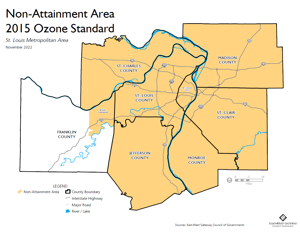The Clean Air Act requires the U.S. Environmental Protection Agency (EPA) to set standards (concentration limits) for pollutants considered harmful to public health and welfare. Six criteria pollutants have a National Ambient Air Quality Standard (NAAQS) — ozone, particulate matter, carbon monoxide (CO), lead, nitrogen dioxide (NO2) and sulfur dioxide (SO2). For additional information on the NAAQS, visit the EPA website.
The standards must protect sensitive populations including children, elderly, and people with existing heart and lung disease. Over time, the EPA has revised and strengthened NAAQS to better protect public welfare from known or anticipated adverse effects. Transportation-related pollutants of concern are ozone and fine particulate matter (PM2.5).
Currently, seven counties and one township in the St. Louis region have been designated by the EPA as not attaining the 2015 eight-hour ozone standard of 70 parts per billion (ppb).
Click on the map below to enlarge the image
Ozone
Ozone exists in both the upper and lower atmosphere. The ozone layer of the upper atmosphere (10-30 miles up) occurs naturally and shields the Earth from harmful ultraviolet radiation. However, ozone in the lower atmosphere (ground-level zone) is manmade and creates a variety of health problems.
Fine Particulate Matter
Particulate matter (PM) is a mix of solid particles and liquid droplets suspended in the air. Fine particulate matter (PM2.5) is considered to be less than or equal to 2.5 microns in diameter (about 1/30 the width of a human hair). Many man-made and natural sources emit PM directly or emit other pollutants which have a chemical reaction in the atmosphere to form PM.
PM2.5 is made up of a variety of components including acids, organic chemicals, metals, dirt, or dust particles. PM2.5 can be emitted directly from the combustion of fuel (power plants, motor vehicles, wood burning) and certain industrial activities. Other fine particle pollution may be formed indirectly from the chemical transformation of gases, such as sulfur dioxide, nitrogen oxides and volatile organic compounds, in the air. PM2.5 can be formed when these gases react with sunlight and water vapor. PM2.5 can affect human health and is a source of haze (reducing visibility).
PM2.5 Standard
1997 Annual Standard
In October 2018 the Missouri portion of the St. Louis region was found by the U.S. Environmental Protection Agency (EPA) to be in attainment of the 1997 annual fine particulate matter (PM2.5) standard of 15 micrograms/cubic meter (ug/m3). In May 2019 EPA redesignated the Illinois counties of Madison, Monroe and St. Clair and Baldwin Township in Randolph county as in attainment of this standard. On the effective date of each redesignation, EPA revoked the 1997 annual PM2.5 standard for these areas. They are considered to be “Maintenance (standard revoked)”.
2012 Annual Standard
EPA strengthened the annual PM2.5 standard to 12 ug/m3 in December 2012. In 2015, as EPA found that it could not determine if the St. Louis region met this standard based on available monitor data, the Missouri and Illinois portions of the region were designated as “unclassifiable”. Based on subsequent three years of quality-assured monitoring data for each state, the St. Louis region was found to meet the 2012 standard. Both Missouri and Illinois submitted a request to EPA to revise the designation to attainment. In January 2019 EPA revised the designation for all of Illinois to attainment/unclassifiable for the 2012 standard. The Missouri counties making the St. Louis region also were designated as attainment/unclassifiable in July 2019.
2024 Annual Standard
In February 2024 EPA strengthened the annual PM2.5 standard to 9 ug/m3. Based on guidance to be provided by EPA, the states then will prepare and submit designation recommendations to EPA by February 2025. EPA will review these recommendations and make final designation of areas attaining of the standard, in nonattainment or unclassifiable (additional monitoring data needed) about one year after that (2026).
PM Health Effects
PM is able to penetrate and lodge in deep areas of the lungs. Health effects include irritation of the eyes, sore throat, coughing, chest tightness, and shortness of breath. PM may also trigger asthma attacks. People most at risk from exposure include those with asthma, heart or lung disease, children and the elderly. Children and adults who are active outdoors may be at increased risk because during physical activity, people breathe faster and more heavily, taking more particles deeper into their lungs. When air quality is poor and if your outdoors activity involves prolonged or heavy exertion, reduce your activity time or substitute another activity that involves less exertion. Furthermore, attempt to plan outdoor activities for days when PM levels are low.
Other Criteria Pollutants
In addition to ground-level ozone and particulate matter, the other criteria pollutants in the NAAQS are also tracked and monitored according to their own standards. These criteria pollutants include: carbon monoxide (CO), lead, nitrogen dioxide (NO2) and sulf
ur dioxide (SO2).


